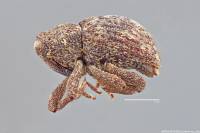Go to Encyclopedia of Life...
Blackish-brown, clothed with dull yellowish and brown scales, which are rather sparse, linear, and appressed on the prothorax; stouter, though about three times as long as wide, on the elytra, where they are closely but not very densely placed; in great part recumbent, but tending to become reclinate toward the sides and apex, especially on the more prominent interspaces. Head and basal portion of the beak densely scaly, scales yellowish on the occiput, dark brown on the front and beak; beak stout, densely punctate, feebly carinate basally. Eyes small, flat, entirely lateral. Antennae pale rufous, first joint of funicle subequal in length to the next two together, second joint about as long as the third and fourth united; seventh as wide as long, club ovate, widest a little beyond the middle. Prothorax nearly as long as wide, broadly constricted in front, moderately rounded just before the middle, thence convergent and nearly straight to base; surface densely evenly punctate, median line not at all carinate or sulcate. Elytra rather broadly ovate, one-third wider than the prothorax, and slightly less than twice as long; humeri not defined; strial punctures rather coarse, close set, the interspaces narrower than the punctures, more or less convex. Scales obscurely mottled without well defined spots or bands, a small pale spot on the third interspace at the summit of the declivity being most noticeable. Beneath very coarsely deeply punctate with sparse linear scales. Legs dark brown, feebly annulate with pale scales. Length 3.4 mm; width 1.7 mm.
A brief examination shows that our species of Acalles are divisible into two sections, in one of which the eyes are widely separated and entirely lateral, while in the other they encroach upon the front, their distance apart being less than the width of the beak. More or less completely correlated with this difference in ocular structure, is the development of the erect bristles; these being entirely or virtually absent in the species with more approximate eyes, and nearly as constantly present in those species having the eyes smaller and widely separated. Hubbardi is a notable exception in the latter group.















